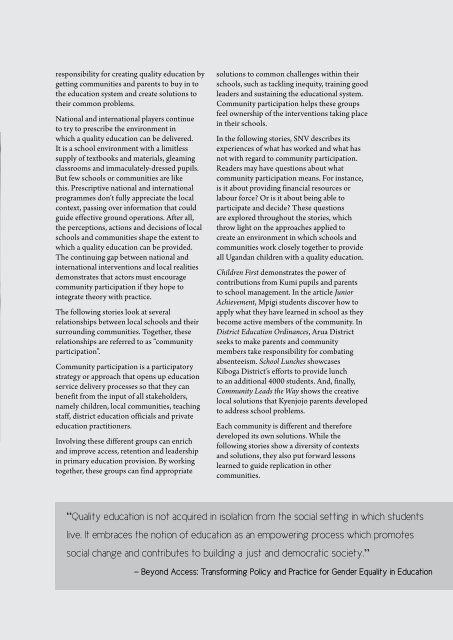School Priorities - SNV
School Priorities - SNV
School Priorities - SNV
Create successful ePaper yourself
Turn your PDF publications into a flip-book with our unique Google optimized e-Paper software.
Community Participation<br />
responsibility for creating quality education by<br />
getting communities and parents to buy in to<br />
the education system and create solutions to<br />
their common problems.<br />
National and international players continue<br />
to try to prescribe the environment in<br />
which a quality education can be delivered.<br />
It is a school environment with a limitless<br />
supply of textbooks and materials, gleaming<br />
classrooms and immaculately-dressed pupils.<br />
But few schools or communities are like<br />
this. Prescriptive national and international<br />
programmes don’t fully appreciate the local<br />
context, passing over information that could<br />
guide effective ground operations. After all,<br />
the perceptions, actions and decisions of local<br />
schools and communities shape the extent to<br />
which a quality education can be provided.<br />
The continuing gap between national and<br />
international interventions and local realities<br />
demonstrates that actors must encourage<br />
community participation if they hope to<br />
integrate theory with practice.<br />
The following stories look at several<br />
relationships between local schools and their<br />
surrounding communities. Together, these<br />
relationships are referred to as “community<br />
participation”.<br />
Community participation is a participatory<br />
strategy or approach that opens up education<br />
service delivery processes so that they can<br />
benefit from the input of all stakeholders,<br />
namely children, local communities, teaching<br />
staff, district education officials and private<br />
education practitioners.<br />
Involving these different groups can enrich<br />
and improve access, retention and leadership<br />
in primary education provision. By working<br />
together, these groups can find appropriate<br />
solutions to common challenges within their<br />
schools, such as tackling inequity, training good<br />
leaders and sustaining the educational system.<br />
Community participation helps these groups<br />
feel ownership of the interventions taking place<br />
in their schools.<br />
In the following stories, <strong>SNV</strong> describes its<br />
experiences of what has worked and what has<br />
not with regard to community participation.<br />
Readers may have questions about what<br />
community participation means. For instance,<br />
is it about providing financial resources or<br />
labour force? Or is it about being able to<br />
participate and decide? These questions<br />
are explored throughout the stories, which<br />
throw light on the approaches applied to<br />
create an environment in which schools and<br />
communities work closely together to provide<br />
all Ugandan children with a quality education.<br />
Children First demonstrates the power of<br />
contributions from Kumi pupils and parents<br />
to school management. In the article Junior<br />
Achievement, Mpigi students discover how to<br />
apply what they have learned in school as they<br />
become active members of the community. In<br />
District Education Ordinances, Arua District<br />
seeks to make parents and community<br />
members take responsibility for combating<br />
absenteeism. <strong>School</strong> Lunches showcases<br />
Kiboga District’s efforts to provide lunch<br />
to an additional 4000 students. And, finally,<br />
Community Leads the Way shows the creative<br />
local solutions that Kyenjojo parents developed<br />
to address school problems.<br />
Each community is different and therefore<br />
developed its own solutions. While the<br />
following stories show a diversity of contexts<br />
and solutions, they also put forward lessons<br />
learned to guide replication in other<br />
communities.<br />
“Quality education is not acquired in isolation from the social setting in which students<br />
live. It embraces the notion of education as an empowering process which promotes<br />
social change and contributes to building a just and democratic society. „<br />
— Beyond Access: Transforming Policy and Practice for Gender Equality in Education<br />
25
















